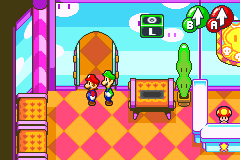All right, I finished updating the script for VBA; before I port it to BizHawk, let me make sure these interfaces seem all right...
Damage calculation:
For damage calculation, you need to pass this struct:
DamageCalculationInput = {
EnemyID,
PlayerID,
PlayerPow,
PlayerPowMult,
PlayerBadgeEffect,
EnemyType,
EnemyDef,
EnemyDefMult,
MushroomCounts = {n, s, u, m},
CurrentHammer,
GreatForce,
IsLucky
}
You can either set EnemyID to an actor # (0-5) and it'll calculate the attack power based on the in-game battle data, or set all of the inputs after PlayerID to calculate what the attack power would be without using the in-game data. PlayerID should never be set; it will be set automatically if you use EnemyID, based on which attack you request the power of.
The functions you call with that data are as follows:
Solo attacks:
{mario | luigi}{Jump | Hammer | Hand | CounterJ | CounterH}(dci)
Examples:
marioJump(dci),
luigiCounterH(dci)
Bros. attacks:
{splash | bounce | chopper | knockback | fire | thunder | swing | cyclone}{Bros | BrosAdv}(dci, (hits/strength if applicable))
Examples:
splashBros(dci),
knockbackBrosAdv(dci, hits),
swingBros(dci, strength)
Lucky! chance:
To calculate the chance of a Lucky! hit, use the following struct:
LuckyCalculationInput = {
EnemyID,
PlayerID,
PlayerStache,
PlayerLevel,
EnemyStache,
EnemyLevel,
LuckyAttack
}
Populate EnemyID & PlayerID (use MarioActorID or LuigiActorID for that) to read from memory in battle, or the rest of the values to try out arbitrary inputs, then call the function
luckyChance(lci). Doesn't support the Lucky Mushroom effect, nor do I intend to support it since it's implicitly supported in the in-battle case anyway.
Stache discounts:
Call
buyPrice(base,dg,stache) or
sellPrice(base,dg,stache), using the base price (not the sell price) of the item, its discount group (0 to 5), and the appropriate STACHE value (Mario's or Luigi's alone if only he can use the item, or their average rounded down if either can).
RNG stuff:
nthRandRange(n,range): Returns the result of rand(0,range) using the Nth RNG value. N is
0-indexed, not 1-indexed, and the function isn't guaranteed to work for N greater than 290-ish.
untwistInRange(n,range): Given a desired value N as the result of rand(0, range), returns an RNG seed value that produces the desired result. Can be useful for testing something with a desired random value, although it won't be of any help if the random engine is pointing near the end of the random buffer.









 I'm starting to understand the bug better. When hitting the wide block, layer 2 holds event pointer related to it. But if you do something that occupies layer 2 as well - such as hitting a saveblock or standing in front of a person or map - then the movement bug happens. It doesn't seem like anything else happens instead of the movement.
I'm starting to understand the bug better. When hitting the wide block, layer 2 holds event pointer related to it. But if you do something that occupies layer 2 as well - such as hitting a saveblock or standing in front of a person or map - then the movement bug happens. It doesn't seem like anything else happens instead of the movement.
 Edit:
There is a wide block in Joke's end (+ a fire place with a cutscene) and in Fungitown (+ 2 NPCs) but the glitch effects aren't very special. The two Toads in Fungitown can't be talked to after the glitch, but no movement happens. You can walk around with speech bubbles there too.
If you do it at the Joke's end fire place, the cutscene event can be stopped which can cause the screen to be stuck forever.
Edit:
Edit:
There is a wide block in Joke's end (+ a fire place with a cutscene) and in Fungitown (+ 2 NPCs) but the glitch effects aren't very special. The two Toads in Fungitown can't be talked to after the glitch, but no movement happens. You can walk around with speech bubbles there too.
If you do it at the Joke's end fire place, the cutscene event can be stopped which can cause the screen to be stuck forever.
Edit:
 Some loading zones are tied to events. That's why this happens. In this case, Mario and Luigi are the object that moves to the wideblock.
Note how the wide block disappears. You can also, alternatively, make a brother disappear (which can softlock the game somewhat).
Edit:
Some loading zones are tied to events. That's why this happens. In this case, Mario and Luigi are the object that moves to the wideblock.
Note how the wide block disappears. You can also, alternatively, make a brother disappear (which can softlock the game somewhat).
Edit:

 The outcomes can be severe (game crashing when pausing or re-entering the room).
~~~
Here is a
The outcomes can be severe (game crashing when pausing or re-entering the room).
~~~
Here is a